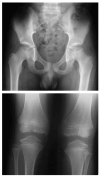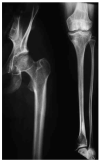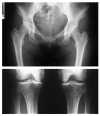Preselection of cases through expert clinical and radiological review significantly increases mutation detection rate in multiple epiphyseal dysplasia
- PMID: 17133256
- PMCID: PMC2670452
- DOI: 10.1038/sj.ejhg.5201744
Preselection of cases through expert clinical and radiological review significantly increases mutation detection rate in multiple epiphyseal dysplasia
Abstract
Skeletal dysplasias are difficult to diagnose for the nonexpert. In a previous study of patients with multiple epiphyseal dysplasia (MED), we identified cartilage oligomeric matrix protein (COMP) mutations in only 36% of cases and suspected that the low-mutation detection rate was partially due to misdiagnosis. We therefore instituted a clinical-radiographic review system, whereby all cases were evaluated by a panel of skeletal dysplasia experts (European Skeletal Dysplasia Network). Only those patients in whom the diagnosis of MED was confirmed by the panel were screened for mutations. Under this regimen the mutation detection rate increased to 81%. When clinical-radiological diagnostic criteria were relaxed the mutation rate dropped to 67%. We conclude that expert clinical-radiological review can significantly enhance mutation detection rates and should be part of any diagnostic mutation screening protocol for skeletal dysplasias.
Figures





References
-
- Briggs MD, Chapman KL. Pseudoachondroplasia and multiple epiphyseal dysplasia: mutation review, molecular interactions, and genotype to phenotype correlations. Hum Mutat. 2002;19:465–478. - PubMed
-
- Rossi A, Superti-Furga A. Mutations in the diastrophic dysplasia sulfate transporter (DTDST) gene (SLC26A2): 22 novel mutations, mutation review, associated skeletal phenotypes, and diagnostic relevance. Hum Mutat. 2001;17:159–171. - PubMed
-
- Unger SL, King LM, Sobetzko D, Superti-Furga A, Cohn DH. A multiplcity of loci for multiple epiphyseal dysplasia. Am J Hum Genet. 2000;67:371.
-
- Jakkula E, Makitie O, Czarny-Ratacjzak M, et al. Mutations in the known genes are not the major cause of MED; distinctive phenotypic entities among patients with no identified mutations. Eur J Hum Genet. 2005;13:292–301. - PubMed
Publication types
MeSH terms
Substances
Grants and funding
LinkOut - more resources
Full Text Sources
Medical
Miscellaneous

